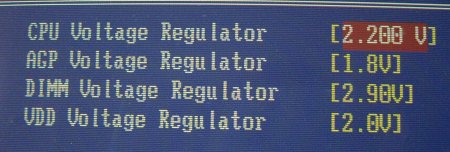BIOS
Ask most informed members of the public and they'll say that EPoX's strength lies with its flexible BIOSes.

Easy to navigate, flexible, simple and functional are some of the adjectives we'd use in describing EPoX's PowerBIOS. Let's head to that section first.

EPoX chooses to separate RAM timings and CPU speed manipulation from the main voltage section. CPU voltage runs from 1.4v - 2.2v in 0.025v increments. AGP voltage, presumably to stabilise cards at high frequencies, sees the default 1.5v - 1.8v. DIMM voltage is a little strange. There's 2.50v, 2.63v, 2.77v and 2.90v options available. We'd liked to have seen 3v+, because a number of high-speed modules now require 2.8v to function at their DDR400+ speeds. What's more, our sample board would under-volt more than a little on each and every line.

This rather lengthy section allows one to adjust the parameters for the CPU and memory speeds respectively. Multipliers run from 5x through to 24x, and the 8RDA3+ unlocks all Bartons automatically. Therefore, those looking for maximum performance will want to knock down the multiplier and raise the FSB of the board and memory. System memory can be run at 50%, 60%, 66%, 75%, 80%, 83%, 100% (1:1), 120%, 125%, 133%, 260%, 166% and 200% of the CPU's FSB. We'd recommend synchronous running, unless you have very poor RAM. We're using our standard 2-2-2-6 timings at DDR400 speeds, helped by some excellent Corsair RAM. One little criticism is that you cannot enter in a specific FSB MHz. You have to scroll up or down the entire list before arriving at your chosen speed.

The 8RDA3G arrives with the MCP South Bridge and no RAID functions at all. That's why the features' screen is a little barren when compared to other boards'. Dual LAN is a nice bonus, though.

An informative motherboard monitoring section is a must. Reporting through a Winbond monitor, the 8RDA3G's monitoring system is about as comprehensive as one gets.









